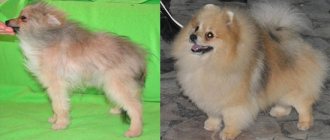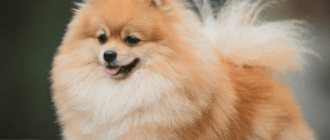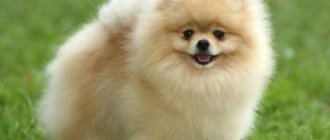The Pomeranian Spitz, or, more simply put, the Pomeranian, is a decorative breed of dog. These little furry animals are very cute and friendly. This breed was originally bred in Germany as a guard dog - to protect homes. The size of the animals was much larger and they were exclusively white and black in color.
Pomeranians in our usual understanding appeared only in the 19th century. If you decide to take this cute creature into your family, then you need to consider several important factors.
Number of newborns
Caring for a toy breed dog is especially important during pregnancy.
Pomeranians have long been domesticated, so the period when puppies are born is especially important for them - at this time the females are extremely vulnerable.
Spitz bear their cubs for an average of 63 - 64 days. However, you need to be careful already on day 58. A dog gives birth to one to three puppies. A dog's small body is not designed to carry more puppies.
Spitz - features of the breed
We need to start with the fact that the Spitz breed group includes a lot of varieties. Northern sled dogs, chow chows, Shiba and Akita Inu, Eurasier and even a whole group of huskies are also Spitz, or more precisely, they have common ancestors with cute bears, which are called Spitz.
Among the classic types of breeds, the following should be highlighted:
- The German Spitz is a classic type, with five varieties: dwarf, small, medium, large and wolfspitz.
- The Pomeranian is probably the most popular, miniature variety of the breed.
- The Japanese Spitz is a medium-sized white dog.
- The Finnish Spitz is a medium-sized, robust, red-colored dog.
- The American Eskimo Spitz is a medium-sized dog of light build, white in color. Bred to be an extremely loyal companion and strictly a family dog.
- The Volpino or Italian Spitz is a small white Spitz.
- The Eurasian Spitz is a medium-sized, very strong and robust dog. The colors are different.
Naturally, the characteristics of the breed will directly depend on the origin and heredity of the puppy. What do all types of Spitz have in common? Strong bones, fluffy coat, strong teeth, agility and activity.
If you want your dog to be beautiful and healthy, first of all you need to feed it properly.
How to choose?
It is best to buy any purebred puppy from a trusted breeder.
Or in specialized nurseries.
In this case, when purchasing, you will be absolutely confident in the pedigree and health of the future pet. Before purchasing, make sure that the offspring and mother are properly fed and kept in comfortable conditions. The first months in a dog’s life are the most important and they should be protected as much as possible from negative environmental factors.
Before buying, you need to understand: for what purpose are you getting a pet? There are three categories:
- Pat is a class - dogs are only for home. They are not suitable for participation in exhibitions and master classes. This is the most budget price category.
- Breed - class - individuals suitable for breeding puppies.
- Show - class - animals for participation in exhibitions.
Before purchasing, you need to decide on your plans and tell a specialist or breeder about them.
Consult a dog trainer - he will help you choose a future champion.
However, it is worth considering that, even if you have an excellent pedigree and meet all standards, your pet may not become a star. However, this will not make him any less devoted to you.
When selecting a future pet for breeding, it is worth checking the pedigree - if the parents pass on their species to the pet, then most often the children will be capable of this.
Puppies for home are the most economical option. In appearance, he is practically no different from his “exhibition” colleagues. Only an experienced dog handler can determine the difference. But at the same time, you will spend a significantly smaller amount of money on the animal, and it will delight you no less than its eminent brother.
Choosing the sex of an animal is also a serious matter. Males are better suited for exhibitions. However, they have a tough temperament and are not as trainable as girls. Bitches also have their downsides. It is necessary to carefully monitor the animal during estrus to prevent unwanted pregnancy, however, even planned offspring will bring a lot of trouble to the owner.
When choosing the right puppy, the “first glance” principle works great.
If you like this or that individual in a pack of dogs, then trust your intuition.
Very often such spontaneously chosen dogs become the best choice . He should be bold and playful, not hide behind his mother's back and react to your presence.
Factors influencing growth
Puppies of the same breed and even the same litter develop differently. Someone seems to repeat standard norms, someone surpasses them, and someone lags behind their peers. Some puppies grow, gain weight in leaps and bounds, while others are in “waiting mode” for a long time in order to catch up and even surpass their sisters and brothers in a matter of weeks.
There are several reasons for this uneven growth:
- Genetic predisposition. Often, a miniature Spitz, having matured, can confidently compete in weight with a standard one. To avoid such a surprise, you should thoroughly study its pedigree before purchasing a puppy.
- Nutrition. Puppies that have the same weight at birth can vary greatly in weight after just a couple of months. One of the main reasons for this phenomenon is the diet and feeding schedule. According to the observations of breeders, puppies on natural food surpass the general indicators, and puppies on dry food develop more harmoniously, practically repeating the standard.
- Physical activity. The more the puppy moves, the more active games in his life, the more harmonious the development. In such an animal, the skeleton is strengthened faster and muscle mass is formed faster. An active dog with normal nutrition will never suffer from obesity or dystrophy.
- Vitamin and mineral supplements. For the harmonious development of a small Spitz, high-quality natural food or professional food is not enough. The animal is offered vitamin and mineral complexes - of the names and dosages that were prescribed by the veterinarian.
Video
Breeder's advice on choosing a puppy.
It is worth paying attention to the appearance:
- The coat should be thick and shiny , without bald spots, tufts or large dandruff - this may indicate improper care of the puppy.
- The pet's skin should be clean , without rashes or folds.
- Condition of the ears : The ears should stand up and be firm to the touch, clean and free of redness.
- Eyes and nose - no purulent discharge.
- A dog must have 12 baby teeth.
- Feel the tummy - there should be no hernia or swelling on it (this may indicate the presence of worms).
- Age – 3 months, plus/minus a couple of weeks. At this age, the posture and exterior are already visible and you can select a puppy both for exhibition and for breeding.
A good breeder, along with registration documents, pedigree and vaccination certificate, will provide a description of the diet, information about future vaccinations and recommendations for a future life with the dog.
First vaccinations
The first vaccinations are given at approximately 2 months. By this time, the immunity received by the puppy from its mother’s milk is already beginning to weaken, and therefore, if the babies are not vaccinated in time, they will catch literally every infection.
As a rule, puppies, and even adult dogs, are given complex vaccines that protect them from several diseases at once..
Such diseases include leptospirosis, hepatitis, distemper, parainfluenza and enteritis - that is, the most dangerous infections for animals, which, even with early treatment, often end in the death of the pet.
Usually, the first vaccine is given at 8-9 weeks . Two weeks after it comes revaccination, which should not be skipped under any circumstances. After this, the dog is vaccinated at 6 and 12 months.
Starting at 12 weeks, the puppy will also need to be vaccinated against rabies..
Care and maintenance
The first thing you need to do is prepare the apartment for the arrival of a new tenant.
Remove all small items, wires, shoes, household chemicals, close all cracks, balcony (if it is open).
Puppies are very inquisitive and will probably explore the territory and try literally everything by heart. So that your acquaintance does not begin with hysterics over a destroyed pair of shoes, protect the dog and yourself.
Don't leave your new pet alone on the bed or couch. When he jumps, he can seriously damage his paws.
Place
Prepare the puppy his place in advance. This could be a comfortable pillow, specially made bedding or soft beds with sides. Most likely, the orange will choose several places in the house. But the first, official place must be chosen by the owner. At first it will be difficult to teach your baby to sleep there, but over time he will get used to it.
Wool
Dog fur does not require serious care, as it might seem at first glance.
However, a puppy must be trained to use a brush from a young age.
Because brushing will be necessary during shedding.
It is also recommended to bathe animals no more than once or once a month and a half, since even specialized shampoos upset the balance of the skin.
The dog has a very thick undercoat and if you decide to give the puppy a bath, then you only need to dry it with a hairdryer. The thick undercoat will take a very long time to dry and the dog may become hypothermic and get sick. It is best to wipe the paws with a wet rag after a walk and comb them with a wet brush in the direction of fur growth and against it.
Recently, the services of a groomer have been gaining popularity - the fur of decorative dogs is trimmed and shaped. This will keep the dog in neat condition, but it is also worth teaching it to grooming from puppyhood. Grooming an adult dog for the first time will be a real stress for him.
Feeding
It is better to feed a puppy under the age of 7 - 8 months 3 - 4 times a day.
Preferably at the same time.
It is better to use specialized food and diversify the dog’s diet with boiled meat and cottage cheese.
You should not give your animal fatty foods, pasta, or sweets . If you are going to give your pet a treat, it is better to use low-fat cheese and ready-made treats.
Changing teeth
Oranges' teeth are very sensitive and prone to caries and periodontitis. Therefore, puppies should be accustomed to a special toothpaste. You also need to be careful when changing teeth. Very often, dogs do not absorb milk roots, which interferes with the growth of permanent ones. Because of this, the Spitz may develop an incorrect bite. In this case, it is better to contact a veterinarian and remove the baby teeth and their roots.
Dry food for Spitz
Dry food is divided into classes:
- Holistic (Acana, Barking Heads, GO!, etc.). Such food is considered elite. Holistics contain up to 70% high-quality animal protein obtained from meat, not by-products. Many diets do not contain grains; instead, fruits and vegetables (potatoes, sweet potatoes, apples, etc.) act as sources of carbohydrates. Holistic food is enriched with high quality probiotics, mineral and vitamin supplements.
- Super-premium (Belcando, 1st Choice, Arden Grange, etc.). Such diets contain up to 30-40% protein of animal origin. Meat is used to make super premium food. Carbohydrates are represented by cereals, which are perfectly absorbed by the Spitz’s body (maize, rice, etc.). It also contains vegetables, fruits, and berries, which enrich the food with vitamins. Super-premium diets do not contain flavorings or dyes harmful to dogs.
- Premium (ProPlan, ProBalance, Purina One, etc.). The quality of these diets is inferior to holistic and super-premium foods. Animal protein can be represented not only by meat, but also by-products. Some proteins are of plant origin. Cereals are represented by corn, wheat and their derivatives. Premium foods also contain vitamins and minerals, but their amounts are noticeably smaller. Some diets may contain flavorings.
- Economy (Pedigree, Trapeza, Darling, Chappi, etc.). These diets are of low quality. The main component is cereals and their processed products. Sources of animal proteins can be by-products and waste from meat processing plants. The composition includes a minimal amount of fortified supplements. Many diets (Darling, Chappie, etc.) contain dyes and flavors.
To what age do they grow?
By 5 - 6 months, the Spitz puppy has grown to its normal size and has finished shedding.
Just at this time, the “baby fluff” disappears.
The period of active growth ends in a year.
An adult dog weighs from 1.4 to 3.2 kg. Do not be afraid if your pet is a little behind or ahead of its relatives. The development of puppies is individual.
Prohibited Products
Spitz are quite strong animals, but many foods should not be given to them. Certain foods can trigger the development of intestinal and stomach diseases and lead to the development of chronic diseases (pancreatitis, kidney failure, etc.).
Prohibited foods for German Spitz:
- semi-finished products (sausages, sausages, dumplings, etc.);
- grapes and raisins;
- pork and broths prepared with this meat;
- garlic, onions and potatoes in large quantities;
- unboiled river fish;
- raw dough prepared using yeast;
- small tubular bones, especially boiled chicken bones.
Having a German Spitz puppy in the house is a big responsibility. A small pet needs a properly formulated diet. Only high-quality products will provide the growing body with all the necessary substances. An incorrect diet will lead to deterioration in coat quality, slow growth, and the development of diseases of the musculoskeletal system.










